In the closing laps of last Sunday’s F1 Brazilian Grand Prix, drama between Red Bull teammates stole the show, sending the internet into a tizzy.
In case you missed it, Max Verstappen held sixth position with less than a lap remaining, one spot ahead of Red Bull teammate Sergio “Checo” Perez. Verstappen, who clinched the driver’s championship over a month ago, was asked to surrender his position to Perez before the two crossed the finish line. An additional spot for Perez would be a welcome boon in points, as the Mexican driver was—and still is—locked in an intense battle for second place in the driver’s championship standings.
Verstappen refused.
“I told you already last time, you guys don’t ask that question,” he said over the team radio. “Are we clear about that? I gave my reasons and I stand by it.” As soon as Verstappen finished his transmission, the F1 world chimed in. Twitter feeds swelled with comments that labeled the young champ as “classless” and “spoiled.”
Wow …ok I guess there is a “I” on a team right there. Just wow
— Tony Kanaan (@TonyKanaan) November 13, 2022
Red Bull held an emergency team meeting following Verstappen’s defiance. When the two-time champ emerged, he vowed to help his teammate in Abu Dhabi. Will it be too little, too late? Time will tell; remember that revenge is a dish best served cold.
The real question is: Was Verstappen justified in his refusal to move over, or should he have surrendered the spot?
Regardless of the discipline, team orders in auto racing have a long and complex history. In North American motorsports, explicit team orders are frowned upon, even penalized, by certain sanctioning bodies. Earlier this year, NASCAR team Stewart-Haas incurred a point penalty and fine when one of its cars slowed to block rivals so that the other Stewart-Haas could squeak by.
- Juan Manuel Fangio, Stirling Moss, Mercedes W196, Grand Prix of Great Britain (Photo by Bernard Cahier/Getty Images)
- Stirling Moss and Juan Manuel Fangio celebrate their collaborative win (Photo by Bernard Cahier/Getty Images)
Formula 1, on the other hand, has adopted the team order tactic since the sport’s early days. In 1955, Mercedes asked Juan Manuel Fangio to let teammate Stirling Moss win in a grand prix in the Englishman’s homeland. Lorenzo Bandini surrendered his position to fellow Ferrari driver John Surtees so that he could notch enough points for the 1964 championship. In 1982—you get the idea.
Most examples of this … strategic collaboration weren’t as accepted as they are today. “I came up watching F1 in the Prost-Senna era, when most considered team orders to go against the intent of the sport,” says Hagerty editor Eddy Eckart. “You either had position on merit or you didn’t, and to slow down in a motor race was the antithesis of the activity itself.”
In the following decade, team orders became common practice. So much so that by the late 1990s, in the throes of Michael Schumacher’s dominance, it was speculated that Eddie Irvine served as Schumacher’s roadblock. Teammate choreography and tactics were morphing into blatant, convoluted exercises to achieve track position or maximize points, feints which sullied the sport’s image.
By 2002, the FIA outlawed team orders.
The ban didn’t last long. Less than a decade, in fact. Ahead of the 2011 season, the FIA deleted article 39.1, which prohibited team orders. Nearly every year since then, team collusion has reared its head in at least one grand prix.
You can’t fault the teams. Modern F1 racing seems to enable the orders. Competitors are constantly searching for the extra edge, that final thousandth. In an era of two-car operations, complex pit strategy, and a high degree of passing difficulty, support from a teammate is just another way to get ahead.
Orders have become increasingly transparent. Think of Valtteri Bottas playing a support role to teammate Lewis Hamilton’s multiple championships with Mercedes, or of last year’s season finale in Abu Dhabi, in which Perez held up title contender Hamilton to help Verstappen secure his first championship. Verstappen applauded his teammate, calling him a “legend” for delaying Hamilton. To borrow a line from the two most dynamic teammates Ricky Bobby and Cal Naughton Jr, in 2019 it appeared the teammates went together like “cocaine and waffles.”
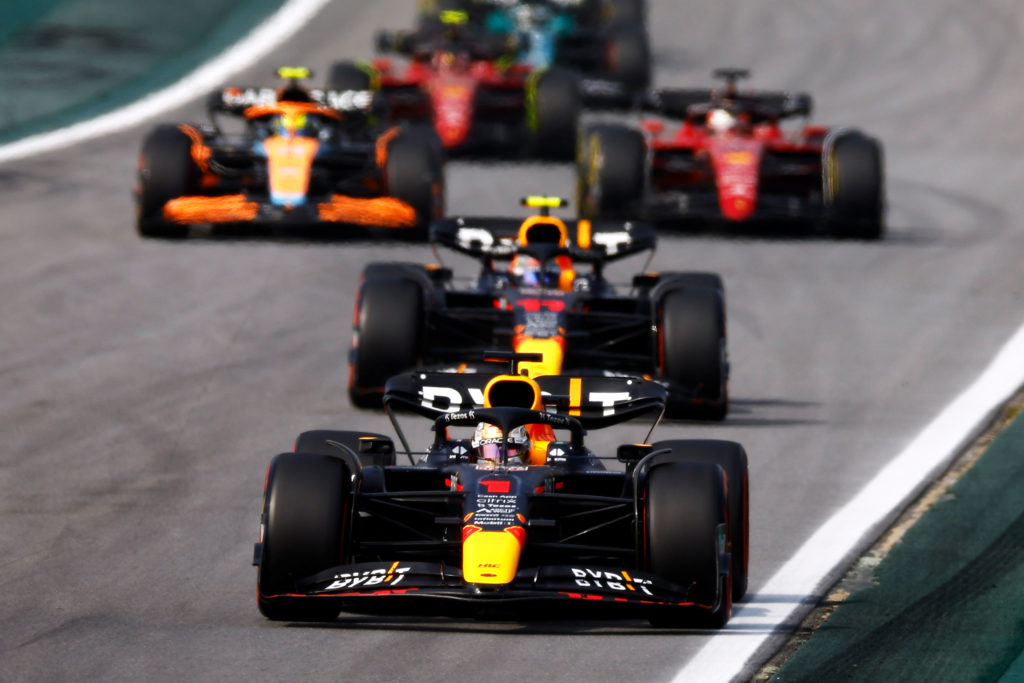
(Photo by Jared C. Tilton/Getty Images)
Last weekend, we witnessed a lack of reciprocation from Verstappen. This is what got F1 fanbase so steamed.
“Eddie Irvine once said being Michael Schumacher’s teammate was like being hit in the head with a cricket bat every other weekend,”says F1 reporter and Hagerty contributor James Foxall. “If you’re the number one driver, giving someone that kind of bruising treatment at every race, you have to give something back. Schumacher settled up when he gifted Irvine the 1999 Malaysian GP.”
“[Brazil] was a chance for Max to give something back,” says Foxall. “And the crazy thing is, it was for sixth place, which on the Red Bull scale of success might as well have been 16th.”
The next time Perez is asked to help his teammate, he may think twice.
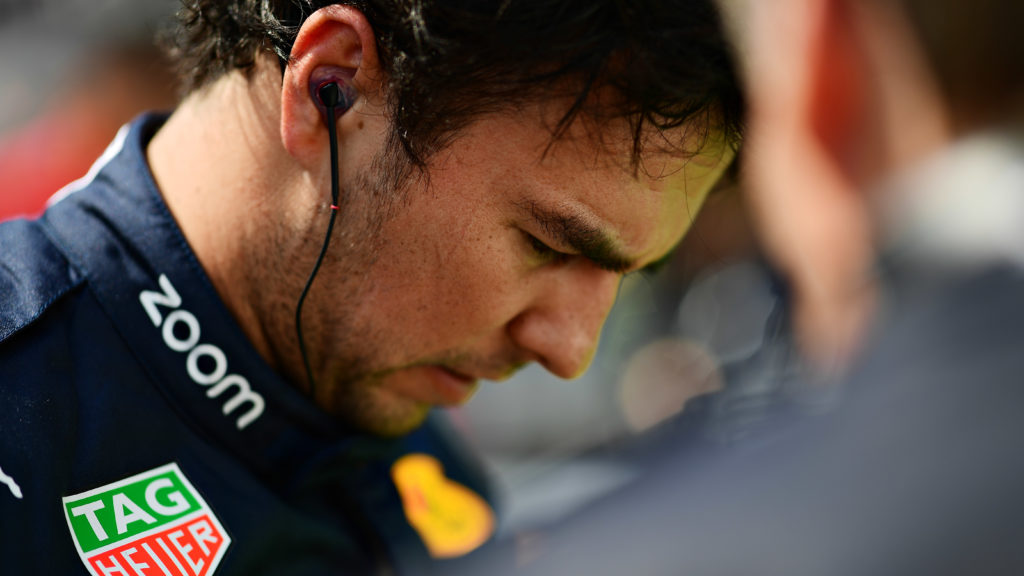
Checo Perez (Photo by Mario Renzi – Formula 1/Formula 1 via Getty Images)
Still, Verstappen isn’t in the wrong.
Fans adore the incredibly talented Dutch driver because he is unapologetically brash, not because he is generous or poised. Just a few minutes before the Perez kerfuffle, Verstappen refused to back out of an overtake on Lewis Hamilton, causing a collision between the two drivers. Verstappen received a five-second time penalty for his aggressive move.
Rather than apologize, Verstappen looked Sky Sports in the eye.
“To be honest, I went around the outside and immediately felt he wasn’t going to leave space, so I just went for it. He didn’t leave me space so I knew we were going to get together. It cost him the race win and it gave me five seconds. It wouldn’t have mattered anything for my race.”

Verstappen and Hamilton collide. (Photo by Bryn Lennon – Formula 1/Formula 1 via Getty Images)
As bull-headed they are, that move and the incident with Perez are true to Verstappen’s character. There’s something to be said for being genuine, especially in an era in which you get the feeling that drivers are reading interview responses off cue cards.
Most of the men on the grid seem to be some combination of handsome, politically correct, and bland. Verstappen is, as Eckart says, “cut from a different cloth.”
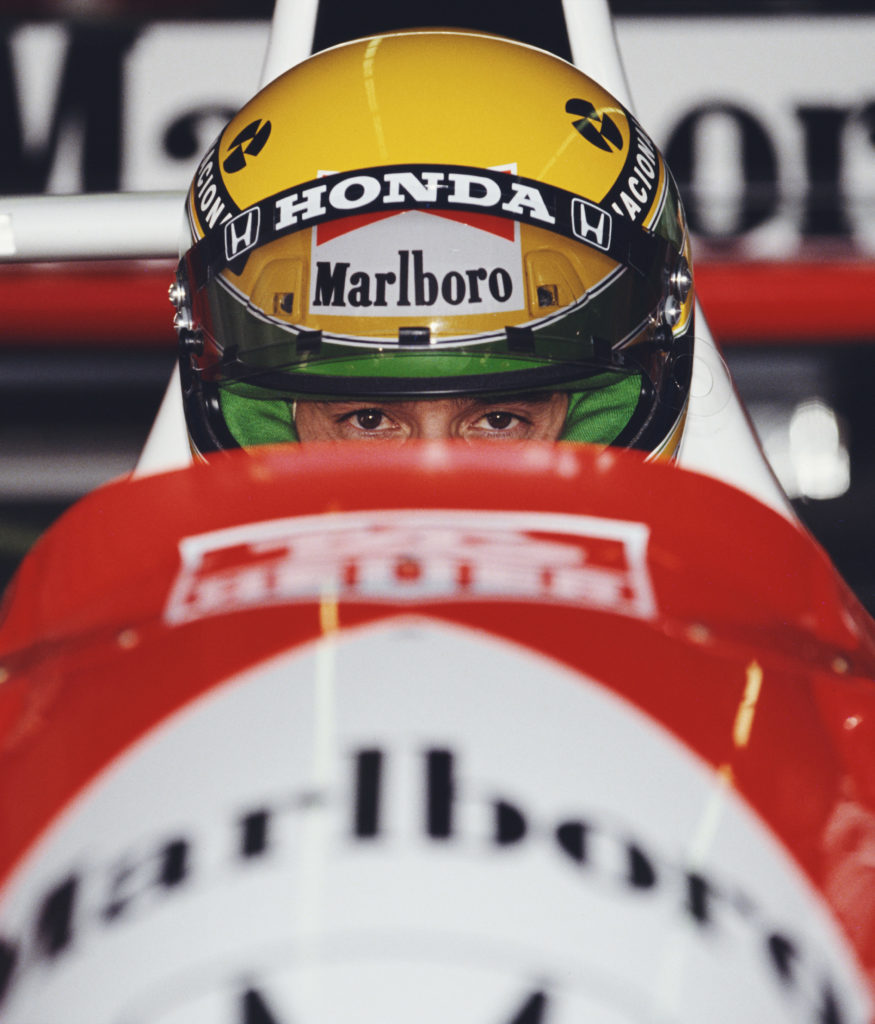
Ayrton Senna (Photo by Mike Powell/Allsport/Getty Images)
Verstappen’s refusal to relinquish a six-place spot underscores the ardent driver’s ruthlessness. Without it, Verstappen likely wouldn’t have had a full season of F1 competition under his belt before he turned 18. He is unrelenting in his pursuit of perfection, a throwback to other hot-blooded legends like Senna and James Hunt. (Go ahead and google “Hunt the Shunt.”)
Intensity is mistaken for selfishness by a new and young F1 fan base. The exponential growth in F1 viewership is well-documented, and it’s reasonable to assume that many of the fans questioning Verstappen’s character haven’t witnessed this type of ferocity. They may be too young or too new to the sport to remember the questionable—yet necessary—moves that won Schumacher seven world titles.
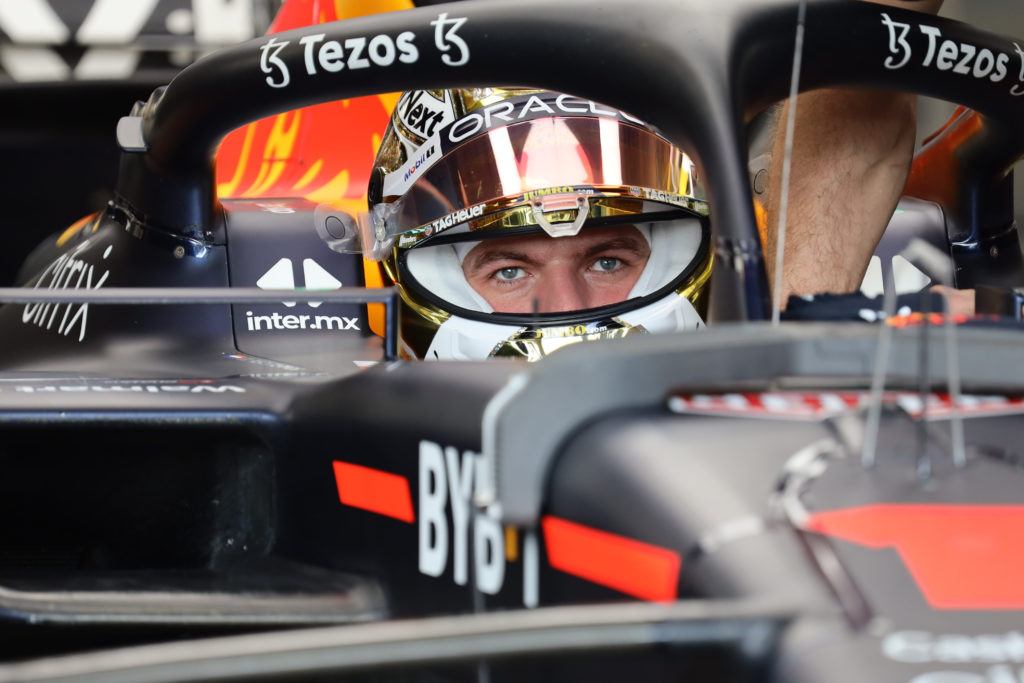
Max Verstappen (Photo by Cristiano Andujar ATPImages/Getty images)
In addition, those that arrived since Drive to Survive may assume team orders are as mandatory as taxes. They are unfamiliar with the sport’s salad days, when it was all take and no give.
Veteran fans of the sport may recall a counterpoint to the no-holds-barred attitude of early 1990s F1, the moment when Senna let teammate Gerhard Berger through to win his first grand prix in 1991. First, let’s point out that this was one blip in the career of a driver who, on the track, took no prisoners. Second, Senna was 31 years old, a veteran who could see the forest through the trees. Verstappen is 25.
Asking Verstappen to backpedal in Sunday’s final lap was a foolish request in the first place. Red Bull should never try to tame the feral genius that hunted down two successive championships and dropped them at its door.
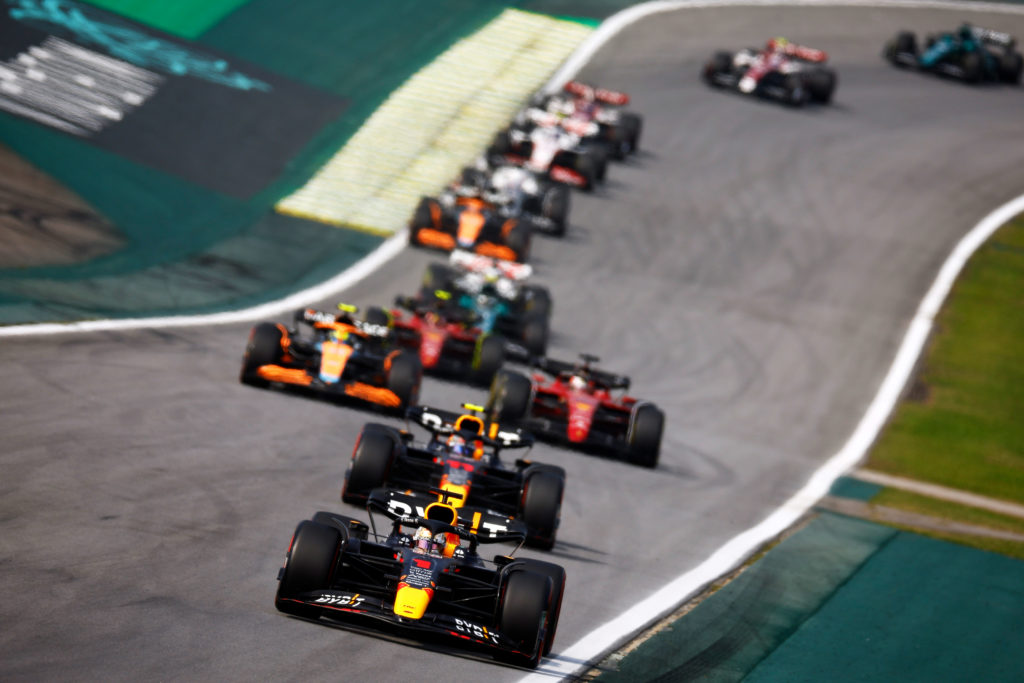
(Photo by Jared C. Tilton/Getty Images)

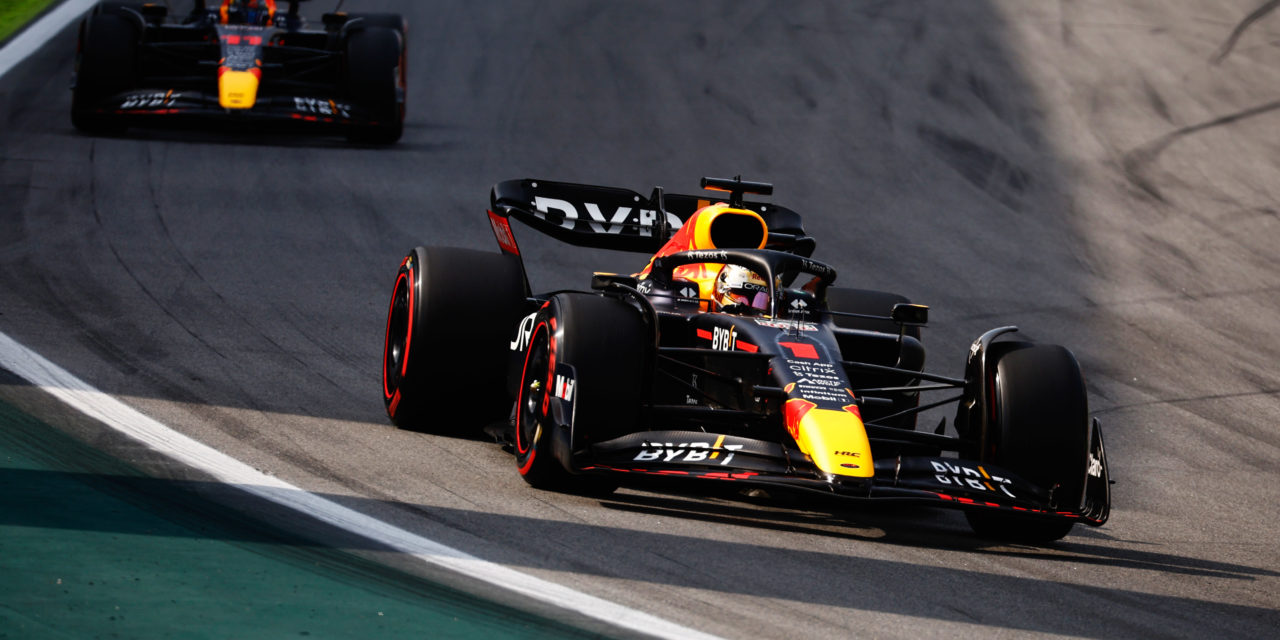
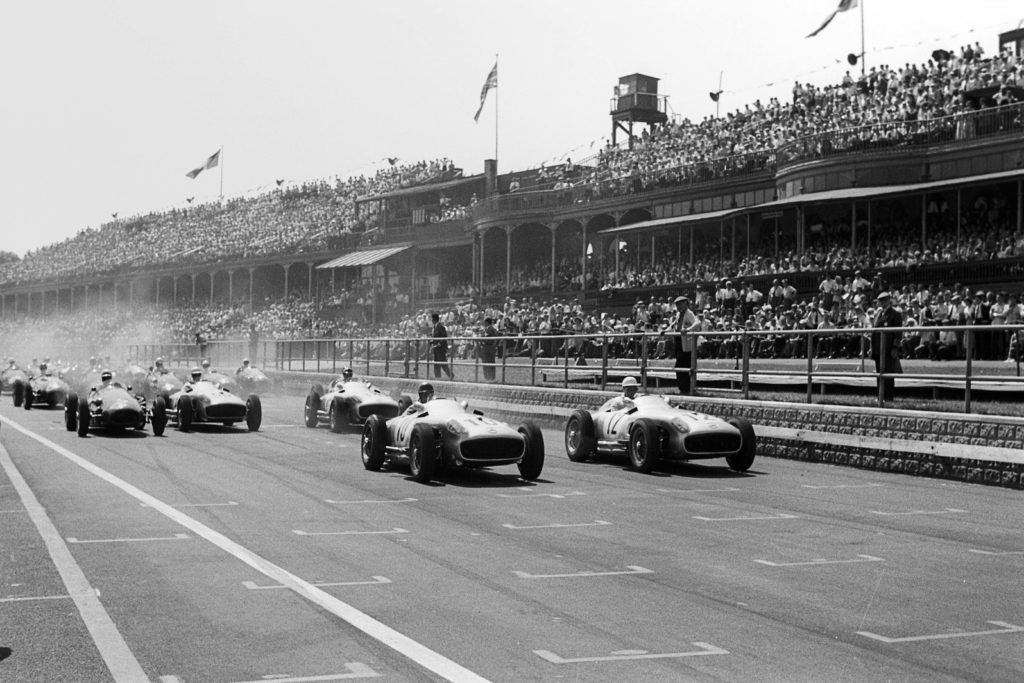
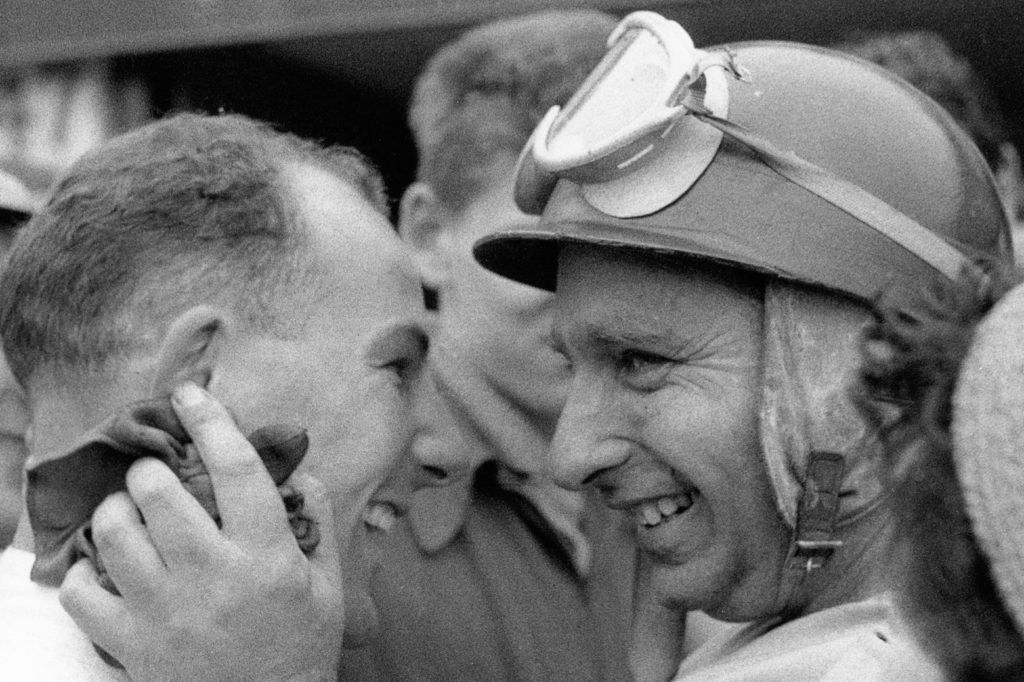









BULL. F1 has become trash and all of the Red Bull antics is a big reason why. Just say your a Max fan and spare us all of your drivel next time, to make your fanboyness seem to be based on anything objective.
I disagree. I am admittedly a new (3 seasons) F1 fan and RB fan, but I too blasted Max for the move. But the writer makes a good point here.
My question remains, however: WHY did Max so vehemently refuse? Seemed like more than just a guy racing hard – Or maybe indeed that’s all it was. And I do like Max’s hard-core competitiveness. In fact that’s the very thing that compelled me to pick him as my favorite racer in the first fee events I ever watched.
I have to agree with others on this thread. Verstappen used to race in the junior formulae against a friend ‘s son. He wasn’t popular then. Arrogant, petulant, selfish, crashed a lot. Nothing has seemingly changed. He won no friends with the Checo incident, either within or outside the team. It’ll tarnish his reputation, not that he’ll care. He’ll never put anything back into the sport or society, unlike the Sennas, Vettels or Hamiltons of this world.
^ facts
Good write up, agree that Max’s personality of take no prisoners is true to form and a reason his fans cheer for him. That said, however, I would put a counter point up that fundamentally it is NOT that Max disobeyed team orders that upset fans like myself (most people can relate and don’t like authority), it was the lack of reciprocation to another person that has been steadfastly supportive to him in real and measurable ways on track that was above and beyond that of an average teammate.
Well said sir.
While I can appreciate his talent and fierce competitiveness, refusing to help a teammate that has helped you achieve a large part of your recent success is pure ego and selfishness.
I could not disagree more. I think Maxy is an insecure bully not unlike Schumacher and Senna. Don’t get in my way or a will punt you, or at a minimum, send you off the track. it will undoubtedly then be your fault and I, Christian and Helmut will cry and complain.
Last year Hamilton was robbed, they cry and say we are not going to speak with Sky Sports. Then the budget thing that was “draconian”. Then the I will not give Perez the position. Selfish and, “that shows who he really is”
I just wonder what was going on that Max could forget that his 1st Championship (mired in quite some FIA rule controversy) was only his due to Checko blocking for him. Being petty is not endearing, and I am a fan of Max, understanding he is young and brash….still, I’d have like to have seen him reward Perez for his help on multiple occasions.
Verstapen will go down in history as the most selfish non team player to ever compete in F1. I can only hope that Perez outperforms him next year. He deserves it more than Verstapen!
Checo significantly better driver than Max
Perez should not have asked for a pass…that’s as good as a “Participant” trophy!
Verstappen showed his “true colors” last season when he ran on top of Hamilton’s car and both cars were against the wall. Verstappen got out and never went to see if Hamilton still in his car was OK. Verytelling verstappen.
Baloney
Intensity? Never an excuse for being a dorf. What part of team does he and you not understand? As good as he may be this season, he was not top dog this race. You will not always be dominant and he only gives a bad memory to his team and any teammate to not trust him in the future. Trust is an important part of the sport, with your team and with other drivers during a race.
I’m a Verstappen fan but I’m that particular race and that particular day I think he should have gave it up. I get it , but in all essence it would have been good for the team.
You must have memory loss, how about Silverstone when Sir Hami took Max out and iput him in the Hospital. Celebrated afterwards like nothing happened.
Can’t agree with your assessment. He knew exactly what was going on. I realize a lot is expected of these drivers, but much is also given. Winning at any cost is an issue of character. He has shown growth and hopefully will continue to the point where he earns back respect.
He may be a great drive but a terrible team mate and real D__K!!! Can stand him or red bull
you’re late to the ball, made no difference.
Verstappen only had 6th place because the team asked Perez to let Verstappen by to pursue the frontrunners. When he couldn’t get it done he was then asked to give the place back and he refused.
You got one thing right, Verstappen is feral. He is also unrepentant and dangerous. He will likely kill someone with his moronic driving. There is not an ounce of sportsmanship in him. F1 would be better off without the Verstappens.
Face it. Some people that win championships are just real aholes. The best example I remember is Mike Hawthorn proudly winning the F1 championship in 1955. He caused the LeMans accident that year that killed a couple drivers and almost 100 spectators. In a 24 hour race he just had to pass a drum-braked Austin Healy before swerving back in front of him to pit with his D-Jaguar, the only car in the race with disk brakes. To avoid hitting him the Healy swerved to the left right into the path of Piere Leveigh’s Mercedes going about 60 mph more than the Healy. The Mercedes had to swerve left also, hitting the Healy and loosing control, vaulting over a 4-ft berm into the air, and down into a packed crowd. Hawthorn went on to win the F1 championship and proudly celebrated being the world champion driver like nothing happened.
Try to keep your facts straight. Hawthorn did not win the drivers championship that year.
The team waved him into the pit at the last second as he passed Lance Maclin in the 100S, also disc braked.
An article written by a Verstappen fan-boy. I place him in the same category with Michael Schumacher and Fernando Alonzo, both very talented drivers in their day, but like Verstappen, narcistic egos and obnoxious as***les. They all acted as if it were their right to expect everyone to humbly get out of their way, and wreck anyone doesn’t move over quickly enough. And of course, after every incident, none of them ever accepted any responsibility for the outcome.
Kinda like Earnhardt?!?!
Max is fast to forget that it is a team and a team effort that allowed him to obtain this last Championship. He gained very little not giving up the place but cost his team and teammate dearly.
As I can understand it is in a champion’s best interest to feel they are the best, but a true champion knows that without their team, it is impossible to win. If he does not find a way to check his ego, he will start to see his weaknesses very fast.
Young Max is an interesting blend of superb talent, unrestrained ego and Jos’ unrelenting and perhaps brutal coaching.
I believe that Steve gehring’s comment pretty much sums it all up. This is “sports/entertainment”, and all competitors want to win. In American football, the coach sends out the plays to the Quarterback, and if he follows it and succeeds, great. And if the Quarterback takes his own play and succeeds, great also. What’s the difference for the fans watching? They are all “team” sports and we all know about the individual antics of competitors on a team, any team.
F1 is a team sport.. it is articles like yours that encourage the average fans to continue to support a selfish, reckless egomaniac. This is not the first time RedBull has had a good car and gone on a winning streak but look at the respect everyone gave Seba at the end when he retired. He was a worthy champion not this Horner puppet who has no regards for authority or team. Teams will catch up to RedBull coming season and then you will see a lot more crashes because the puppet will take all sorts of risks and take cars off the track if he is not doing well.
First I am a Max fan. I do think he should have help his teammate. However I think what should be corrected is team orders. Make them illegal be it blocking or backpedaling. Personally, anything that contributes to going slow is poor racing. Be it tire “ management “ stretching or limiting fuel etc . Let’s get back to racing every lap! My favorite racing is still the can am group 7 cars
Max is one heck of an f1 driver and his record proves it. However, his attitude shows how selfish and self centered he really is. I have no respect for him at all and hope his win streaks comes to an end. He cut his own throat with his ME, ME, ME attitude and lost a lot of support from f1 fans. Go away Max, the sport doesn’t need players like you. Take all the $$ you’ve earned and go away.
Just wait until Checo is asked to move over. Grow up Max.
New rule, he gets no help from Perez. You are either a team, or you are not a team
Either you are teammates or you are not. Verstappen acts as a team member when it is convenient or advantageous to him, which is the worst kind of teammate. Red Bull would be better off just letting them race full on, and accept the consequences of the inevitable friction that would result vs. trying to manage someone (Verstappen) who really only cares about one thing, Verstappen. This fact cannot be changed, so don’t pretend you can. I believe that were Red Bull to take this stance, Verstappen would shrug, say “fine”, and get on with winning races.
I’m a Max fan but in this case the points made no difference to him but for Checo it did. No reason for Max not to give the place back.
VER is a very talented driver but a s–t as a team mate. He’s lost me as a fan but so what.
It takes a particular mentality to be a winner & the best…any sport and at whatever level, but esp. at the top level…look at the top person in any sport and you’ll regularly find an intensity, demeanor and focus that cannot be easily understood by most people, and the person often comes across as abrasive and/or harsh (Michael Jordan from NBA is a perfect example). Max is not there to be a great guy…he is there to win races and he’s doing it better than everyone else.
I’ve know some real jerks in racing and in other sports. No matter how good they are at what they do, they are still jerks, and their fellow competitors tend to avoid them. They never seem to care until age catches up with them and they mellow somewhat. By then it is usually too late.
First, let’s be clear: Versteppan has WON only one F-1 World Championship, that in 2022. 2021 was a gift handed to him by an utterly corrupt and/or incompetent race director whose actions were repudiated by the FIA, but which was to timid to undue the race and championship results.
Second, it isn’t just a single event or action by Versteppan that drives fans away. He has a long history of reckless and dangerous driving. He has caused far more than his share of race-ending accidents. He wins races either because his car is superior to any others (2022) or because he has endangered his and other drivers’ lives with stupid, dangerous moves that demonstrate immaturity and lack of judgment far more than racing prowess. One would have thought that his brash driving style when he was 18-20 would have tempered with age and experience. But he is still the bully and it will catch up to him some day.
For now, he is a one-time champion with an illigitamate title that will forever sully his reputation — as it should!
On the Max issue…he showed his true colours! He owes his 2021 and 2022 driver’s championship to Checko…absolutely no question…and to deny Checko a chance to finish second in the Driver’s championship…selfish, arrogant, unsportsmanlike…it made absolutely no difference to Max if he finished behind Checko!!! And, has it ever been disclosed as to what Max was referring to when he said that the team knows his reason for doing what he did? I haven’t heard it. Unless Checko slept with Max’s girlfriend, I’m not sure what Checko could have done that would warrant such a defiant and petty reaction. And i don’t but that it was the Monaco incident. On top of all this, Max blatantly defied a ‘team order’…so the question here is…who runs the Red Bull team??? There’s the whole being ruthless and take no prisoners attitude that seems to be what’s required to be an F1 champ and then there’s being Max…you can’t play in my sandbox unless you play by my rules. On F1 in general…way too many rules and regulations, the minutiae of which have diluted the sport. Team orders should not be allowed…PERIOD…as is the case in the majority of North American racing series. Drivers should be allowed to race…you want to dive into the corner on the inside of another car…you take your chances. If you choose to put yourself in a precarious situation you better be willing to deal with the outcome…good or bad. The FIA is letting all these rules and regulations control F1 races…pure racing is a thing of the past. Don’t get me wrong, there needs to be controls in place for driver safety but the way the FIA is imposing ‘driving’ regulations, it’s made the sport boring. So much more to say but I better stop here. Cheers!
I think based on the majority of anti-Max comments here, I really don’t need to comment further, but after over 40 years of watching racing, I’ve witnessed a few spoiled jerks in my time, but nothing like Verstappen. What’s amazing to me is, the gullable nature of people who think MV is this lovable boy next door. He’s a spoiled jerk and to some earlier points made, had Perez not done such a masterful job of holding up Hamilton last year, Red Bull might not have back to back championships. Max is a perfect match for his spolied role model Christian Horner. I know people love to hate winners, but in this case, it’s very well deserved!
Couldn’t disagree more. Max had already wrapped up the championship and had nothing to gain by defying team orders. Completely unsportsmanlike for him to deny Checo extra points when he needed every point to fight for second place in the driver’s and constructor’s championships. Not to mention the countless times Checo deferred to his teammate to help him win back to back championships. Aggressiveness on the track is part of the sport but it needs to be balanced with being a team player and not just looking out for his own self interest. It is a team sport and Max has some learning and growing to do. As for his altercation with Lewis, I put the blame on Lewis for that one. Max was even with Lewis on the outside going into turn one and had the inside line going into turn two and had nowhere to go but the curb because Lewis didn’t leave him enough room. He had every right to hold his line as far as I am concerned.
Holding up sports figures as role models is a questionable pursuit regardless. But in high level events, the “go-for-the jugular” mentality is not uncommon. It’s how many achieve their personal goals. I like to site Ford’s first win at Leman, when Ken Miles was asked to slow up for an arranged photo finish which ended up costing him a three time championship which no one else had ever achieved prior or since.
Sporting mentality can be debated forever…and I guess that is what make it such an interesting and undying topic.
No doubt Max is a very talented driver. Maybe not such a good sportsman. Interesting that his mom decided to trash Checo. If that is how his mom raised him, it isn’t such a surprise that he isn’t much of a team player.
Stop with the Verstappen apologies. This young boy had the table set for him by his champion father. Therefore he feels he is owed something. Not true. It is motor racing and you are owed nothing.
HIs first championship was won for him by track stewards enabling him to close up on Hamilton with fresh tires and win the race and the championship.
HIs second championship was more fairly won as Red Bull just made a better car than anyone else. His selfish behavior AFTER he had won the world championship again indicates to me that he will NOT follow team orders which is fine. But let’s remember what a champion is………..a winner with the grace to promote his team as well as himself. To chop off Perez points chance is the case of a child, not a man…………a racer, not a champion.
He should not be allowed to wear #1 next season. And I, for one, will be pulling very hard for Perez to have at least one change the return the favor.
I remember a NASCAR race in the 1950’s in Lehi, Arkansas where two (2) bothers were driving Chrysler 300’s and on the final lap one brother was leading the other and he ran out of gas, the second place brother push his brother around the track for the win. I am sure there were not radio communications then, just secure a win for the team!!!
Do people watch racing hoping to see their own mediocrity reflected in world champions?
It seems that as we are acknowledging/celebrating the achievements of most laps led, most races won, most points scored, it makes sense for a fiercely competitive driver to want it all, no quarter given. Ends justify the means.
I agree with most of the emails that Max should have given up the spot. But we do not know everything and Max alluded to as much in his rado message to the team that he had his reasons. They sort of kissed and made up afterwards maybe just for show. I think Max is a great driver and as with Senna, Schumacher, Alonso and Hamilton their greatness spurs the team on so it is a major reason the car becomes the best.
No no, he is well understood by most of us and the rest of you are waving orange flags and blowing orange smoke.
Your article leaves out one essential part. This is a SPORT – and a dangerous one at that. Verstappen’s behavior would be reasonable in COMBAT, where there are no rules. Here there are, many written but some simply the cultural rules of decent behavior. Had this been a martial arts contest, and Verstappen done as many illegal moves as he has in his “career”, he would be banned from further competition. I, for one, think a 2-year suspension of his F1 license, with the stipulation that if his behavior doesn’t improve, the ban will be reimposed for lots longer, would be a reasonable resolution to “Max”.